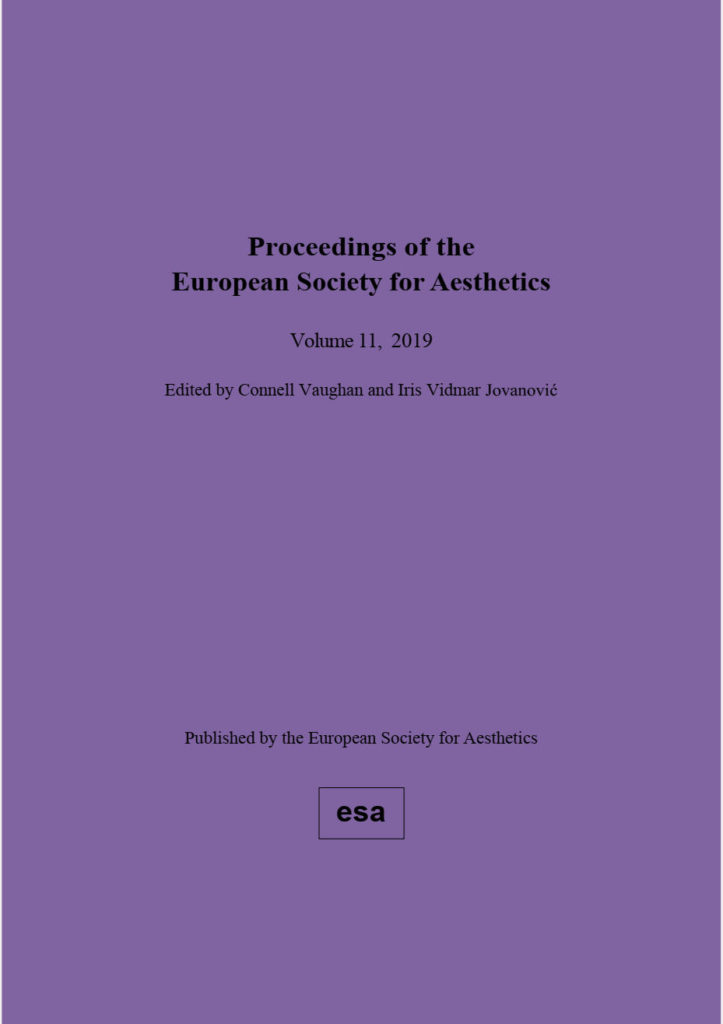|
Lydia
Goehr [Keynote Paper]
|
Painting in
Waiting Prelude to a Critical Philosophy of History and Art
|
1-30
|
|
Lucas
Amoriello
|
(Non)Identity:
Adorno and the Constitution of Art
|
31-42
|
|
Claire Anscomb
|
Photography, Digital Technology, and Hybrid Art
Forms
|
43-59
|
|
Emanuele Arielli
|
Strategies of Irreproducibility
|
60-76
|
|
Katerina Bantinaki, Fotini Vassiliou, Anna Antaloudaki,
Alexandra Athanasiadou
|
Plato’s Images: Addressing the Clash between Method
and Critique
|
77-105
|
|
Christoph Brunner & Ines Kleesattel
|
Aesthetics
of the Earth.
Reframing
Relational Aesthetics Considering Critical Ecologies
|
106-126
|
|
Matilde
Carrasco Barranco
|
Laughing at Ugly
People. On Humour as the Antitheses of Human Beauty
|
127-159
|
|
Rona Cohen
|
The Body Aesthetic
|
160-173
|
|
Pia
Cordero
|
Phenomenology
and Documentary Photography.
Some
Reflections on Husserl’s Theory of Image
|
174-193
|
|
Gianluigi
Dallarda
|
Kant
and Hume on Aesthetic Normativity
|
194-213
|
|
Aurélie Debaene
|
Posing Skill: The Art Model as Creative Agent
|
214-231
|
|
Caitlin Dolan
|
Seeing Things in
Pictures: Is a Depicted Object a Visible Thing?
|
232-248
|
|
Lisa Giombini
|
Perceiving Authenticity: Style Recognition in Aesthetic
Appreciation
|
249-271
|
|
Matthew
E. Gladden
|
Beyond
Buildings: A Systems-Theoretical Phenomenological Aesthetics of “Impossible”
Architectural Structures for Computer Games
|
272-318
|
|
Moran Godess-Riccitelli
|
From
Natural Beauty to Moral Theology:
Aesthetic
Experience, Moral Ideal, and God in Immanuel Kant’s Third Critique
|
319-338
|
|
Xiaoyan Hu
|
The Moral Dimension of Qiyun Aesthetics and Some
Kantian Resonances
|
339-374
|
|
Jèssica
Jaques Pi
|
Idées
esthétiques et théâtre engagé: Les quatre petites filles de Pablo Picasso
|
375-398
|
|
Palle
Leth
|
When Juliet Was the Sun: Metaphor as Play
|
399-430
|
|
Šárka
Lojdová
|
Between Dreams
and Perception – Danto’s Revisited Definition of Art in the Light of
Costello’s Criticism
|
431-447
|
|
Sarah
Loselani Kiernan
|
The ‘End of Art’
and Art’s Modernity
|
448-482
|
|
Marta
Maliszewska
|
The Images
between Iconoclasm and Iconophilia – War against War by Ernst Friedrich
|
483-505
|
|
Salvador
Rubio Marco
|
Imagination,
Possibilities and Aspects in Literary Fiction
|
506-521
|
|
Fabrice
Métais
|
Relational Aesthetics and
Experience of Otherness
|
522-540
|
|
Philip
Mills
|
The Force(s) of Poetry
|
540-555
|
|
Yaiza
Ágata Bocos Mirabella
|
“How Food can be
Art?” Eating as an Aesthetic Practice. A Research Proposal
|
556-574
|
|
Zoltán
Papp
|
‘In General’ On
the Epistemological Mission of Kant’s Doctrine of Taste
|
575-621
|
|
Dan
Eugen Ratiu
|
Everyday
Aesthetics and its Dissents: the Experiencing Self, Intersubjectivity, and
Life-World
|
622-649
|
|
Matthew Rowe
|
The Use of Imaginary Artworks within Thought Experiments in the
Philosophy of Art
|
650-671
|
|
Ronald
Shusterman
|
To Be a Bat: Can
Art Objectify the Subjective?
|
672-699
|
|
Sue
Spaid
|
To Be Performed:
Recognizing Presentations of Visual Art as Goodmanean ‘Instances’
|
700-727
|
|
Małgorzata A. Szyszkowska
|
The Experience of Music: From Everyday Sounds to
Aesthetic Enjoyment
|
728-747
|
|
Polona
Tratnik
|
Biotechnological Art Performing with Living Microbiological Cultures
|
748-765
|
|
Michael Young
|
Appreciation and Evaluative
Criticism: Making the Case for Television Aesthetics
|
766-780
|
|
Jens Dam Ziska
|
Artificial Creativity and Generative Adversarial Networks
|
781-800
|
